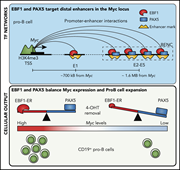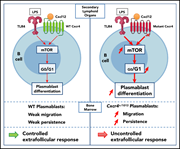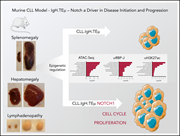Issue Archive
Table of Contents
BLOOD COMMENTARIES
REVIEW ARTICLE
Diversity, localization, and (patho)physiology of mature lymphocyte populations in the bone marrow
Schürch et al review the diversity, localization, and function, both normal and pathological, of key mature lymphocyte populations in the bone marrow. They focus on B cells, T cells, and innate lymphoid cell populations, addressing their roles in homeostasis, upon immune challenge, and in nonneoplastic hematological disorders such as aplastic anemia and immune thrombocytopenia, as well as in allogeneic stem cell transplantation.
CLINICAL TRIALS AND OBSERVATIONS
Dose/schedule-adjusted Rd-R vs continuous Rd for elderly, intermediate-fit patients with newly diagnosed multiple myeloma
Clinical Trials & Observations
Optimizing outcomes for older patients with multiple myeloma requires achieving the right balance between efficacy and toxicity during ongoing first-line therapy. Larocca and colleagues report a randomized trial with patients with intermediate fitness, comparing standard continuous lenalidomide-dexamethasone (Rd) with a modified regimen (Rd-R) that omits steroids after 9 months and reduces the dose of lenalidomide. The modified regimen delivers similar survival outcomes with less toxicity and offers a new alternative standard for a subgroup of older patients.
HEMATOPOIESIS AND STEM CELLS
IMMUNOBIOLOGY AND IMMUNOTHERAPY
Hematologic disorder–associated Cxcr4 gain-of-function mutation leads to uncontrolled extrafollicular immune response
LYMPHOID NEOPLASIA
TLR9 expression in chronic lymphocytic leukemia identifies a promigratory subpopulation and novel therapeutic target
Kennedy and colleagues describe a Toll-like receptor 9 (TLR9)–driven autocrine loop that supports progression of chronic lymphocytic leukemia (CLL) and therapeutic evasion, mediated by synergistic survival signaling via NF-κB and STAT3. These findings in patients suggest a potential CLL treatment strategy using combined targeting of TLR9 and Bruton tyrosine kinase.
MYELOID NEOPLASIA
Clonal evolution of acute myeloid leukemia with FLT3-ITD mutation under treatment with midostaurin
Addition of the multikinase inhibitor midostaurin to induction chemotherapy improves outcomes in FLT3-ITD–mutated acute myeloid leukemia (AML), but relapse remains common. By studying the mutational profiles of samples from randomized trials with and without midostaurin added to chemotherapy, Schmalbrock et al reveal that relapsed leukemia displays increased heterogeneity, implying multiple mechanisms for resistance. With midostaurin treatment, AML is less likely to be FLT3-ITD positive at relapse and more likely to be driven by emergent activating mutations in other growth factor pathways.
PLATELETS AND THROMBOPOIESIS
RED CELLS, IRON, AND ERYTHROPOIESIS
Circulating mitochondrial DNA is a proinflammatory DAMP in sickle cell disease
Tumburu et al report abnormal retention of mitochondria in circulating erythrocytes in sickle cell disease and the presence of mitochondrial DNA (mtDNA) in plasma. Cell-free mtDNA is disproportionately hypomethylated, triggers formation of neutrophil extracellular traps, and acts as a damage-associated molecular pattern (DAMP) in patients. This report adds insight to the complex processes by which sickle erythrocytes can increase inflammation beyond the damage caused to the vessel wall.
THROMBOSIS AND HEMOSTASIS
Clinical phenotype, fibrinogen supplementation, and health-related quality of life in patients with afibrinogenemia
Clinical Trials & Observations
Congenital afibrinogenemia is a very rare autosomal recessive bleeding disorder, with manifestations ranging from minimal bleeding to life-threatening hemorrhage and thrombosis. Casini and colleagues report an international cross-sectional study of 204 patients focusing on the clinical phenotype, quality of life, and management strategies, including prophylaxis with fibrinogen concentrates or cryoprecipitates.
Cryo-EM structures of human coagulation factors V and Va
Ruben et al present detailed structures of coagulation factor V (FV) and FVa generated through cryo-electron microscopy (cryo-EM). This study provides unprecedented structural detail on conformational changes in FV upon its activation. These changes control not only its ability to enhance coagulation but also how it is regulated and degraded.
LETTER TO BLOOD
Proof of concept for a rapidly switchable universal CAR-T platform with UniCAR-T-CD123 in relapsed/refractory AML
BLOOD WORK
-
Cover Image
Cover Image
![issue cover]()
Cryo-electron microscopic structure of human factor V showing the constitutive domains A1 (wheat), A2 (pale green), B (light blue), A3 (pale yellow), C1 (light pink) and C2 (pale cyan) with sites of functional significance. See the article by Ruben et al on page 3137.
- PDF Icon Front MatterFront Matter
- PDF Icon Table of ContentsTable of Contents
- PDF Icon Back MatterBack Matter
- PDF Icon Editorial BoardEditorial Board
Advertisement intended for health care professionals
Email alerts
Advertisement intended for health care professionals














Addition by subtraction
Clinical Trials & Observations